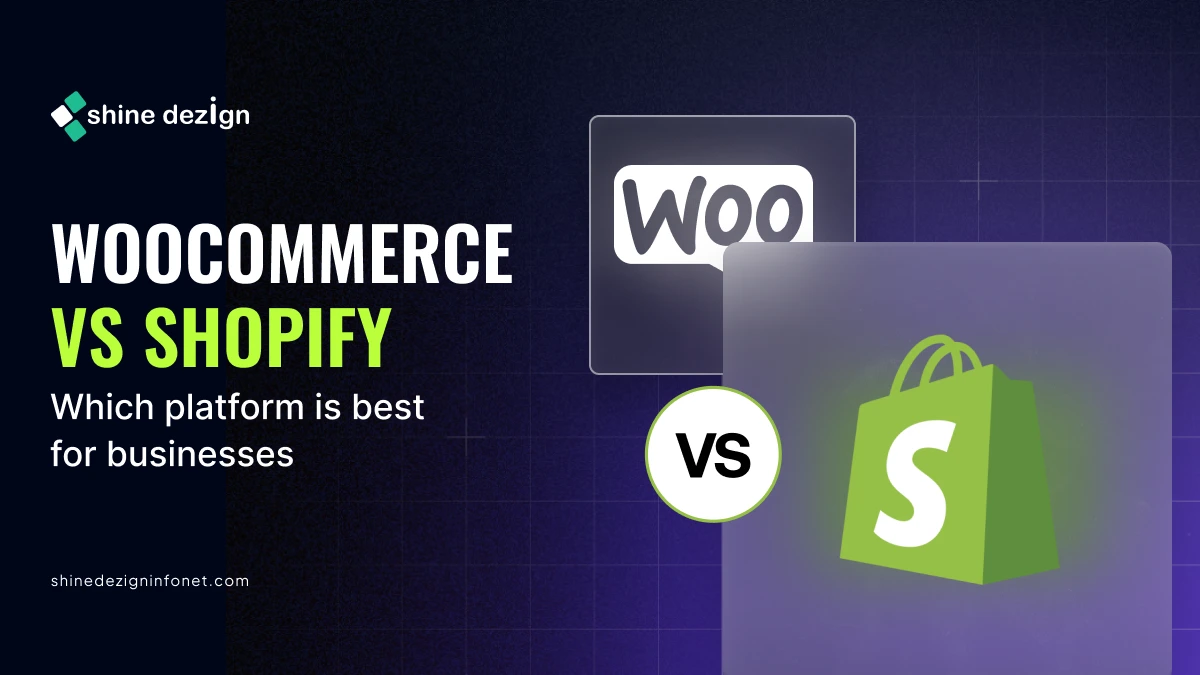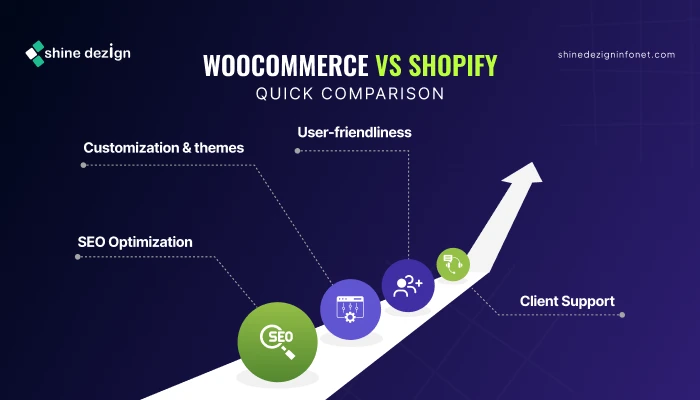Table of Contents
The global eCommerce market is projected to reach $214.5 trillion by 2033, with a CAGR of 25.83% from 2025 to 2033. Therefore, with the buzzing eCommerce market, there’s no better time to launch your store. If you have decided to launch your store but are confused between the two best eCommerce giants, WooCommerce and Shopify, both come with a plethora of features, benefits, and robust support.
Therefore, to give you a more precise and concise picture of both platforms, we have covered a detailed guide on WooCommerce vs Shopify, depending on their market value, features, ratings, and more. Let’s get started.
Woocoomerce vs Shopify: Market Share
 Woocommerce and Shopify, the prominent key players in the eCommerce industry, have good market value and growth. Let’s look at the vital stats of both platforms.
Woocommerce and Shopify, the prominent key players in the eCommerce industry, have good market value and growth. Let’s look at the vital stats of both platforms.
| Overview | WooCommerce | Shopify |
|---|---|---|
| Market Share | 18.2% | 28.8% |
| Active Stores | 4.6 million | 4.82 million |
| Themes | 1,500 themes | Huge marketplace with more than 100+ customizable and responsive themes |
WooComerce Stats 2025
WooCommerce is an open-source eCommerce platform developed and designed for small to large businesses. WooCommerce operates on the WordPress platform. It was published in 2011 and helped developers create plugins that companies can utilize to personalize their stores.
- Let’s look at the vital statistics of WooCommerce
- There are about 4,650,399 active stores on WooCommerce
- 9.1% of WooCommerce stores are in the United States
- WordPress is used by 94.4% of WooCommerce stores.
- WooCommerce.com sells 1,028 official WooCommerce plugin extensions.
- 48.4% of WooCommerce stores have a .com domain.
Shopify Stats 2025
Shopify is the dominant eCommerce platform with a vast customer base and impressive growth. Established in 2006, Shopify has around 2,1 million active users daily. Another advantage of Shopify is that it’s a self-hosted platform, so you don’t need to worry about the store’s technical factors like hosting, domains, backups, or SSL certificates.
Let’s look at vital statistics of Shopify
- There are around 4.82 million stores on Shopify
- 39.1% of Shopify stores are in the United States.
- 67.3% of Shopify stores have a .com domain.
- There are over 10,000 apps on the Shopify app store.
- 21.3% of Shopify stores sell Apparel products.
WooCommerce vs Shopify: Quick Comparison
| Feature | WooCommerce | Shopify |
|---|---|---|
| Type | Open-source WordPress plugin | Hosted eCommerce platform |
| Pricing | WooCommerce pricing includes Free / basic plugin which starts at $1 | Shopify pricing includes Free/basic which starts at $29 |
| User Friendliness | Requires more technical know-how | Very beginner-friendly and intuitive |
| Hosting | Self-hosted (you need to get hosting) | Hosting included |
| Customization | Highly customizable (if you know code) | Limited customization unless on higher plans |
| Design Flexibility | Thousands of WordPress themes available | Professional templates (some free, many paid) |
| Cost | Free plugin, but you pay for hosting, SSL, etc. | Monthly plans starting from $29/month |
| Payment Options | Supports many gateways (some need add-ons) | Built-in Shopify Payments + others |
| Scalibility | Highly scalable with proper setup | Scalable but might require expensive plans |
| Add-ons and Apps | 50,000+ WordPress plugins | 8,000+ apps on the Shopify App Store |
| SEO | Strong SEO via WordPress | Good SEO features, but less flexible |
| Support | Community support; paid support via host/devs | 24/7 customer support |
WooCommerce vs Shopify: User-friendliness
Developing a Shopify store is faster than setting up a WooCommerce store. Shopify is a fully hosted platform, so you don’t need to set up anything. All you need to do is log in to Shopify and develop your store.
Speaking about WooCommerce, first, you need to set up WordPress hosting and install the WooCommerce plugin, which can be time-consuming and create confusion among newbies with less technical knowledge. So, in this case, Shopify becomes the winner.
WooCommerce vs Shopify: SEO Optimization
Search Engine Optimization plays a significant role in marketing your store online. The stronger your store’s SEO, the more visible it becomes in search engine results, making it more seamless for potential clients to Shop and find with you.
Let’s break down how WooCommerce and Shopify stack up in two critical SEO-related areas:
Website Speed
Page speed mainly refers to how quickly your store’s content loads when someone visits it. It’s a key ranking factor utilized by search engines like Google. Generally, faster websites rank better in search results and offer a seamless user experience.
Also, Shopify tends to outperform WooCommerce in terms of speed. It’s a hosted solution optimized for performance out of the box.
Moreover, WooCommerce, being open-source and plugin-heavy, can suffer from slower load times, especially if it is overloaded with performance and SEO plugins. Unless well-optimized, each added plugin can increase server load and drag down website speed.
Shipping Methods
The speed and efficiency with which your clients receive their orders are vital for the overall client experience. WooCommerce provides much flexibility, but you must utilize extra plugins to add features.
Regarding shipping, WooCommerce offers high flexibility but often requires additional plugins to unlock advanced features. With WooCommerce, you can set up flat-rate shipping for different regions, provide free shipping based on order value or location, and enable real-time shipping rates by integrating plugins that connect with carriers like UPS, FedEx, or DHL.
Using the appropriate plugins, you can also provide local delivery options or allow customers to pick up their orders in-store again. While the possibilities are extensive, configuring these features can be complex, especially for users who aren’t experienced with managing WordPress plugins.
On the other hand, Shopify simplifies the shipping process with built-in tools that require minimal setup. It supports live shipping rates out of the box and automatically synchronizes with major carriers such as Royal Mail, UPS, and DHL to provide accurate shipping costs during checkout. Shopify also offers its shipping solution.
WooCommerce vs Shopify: Customization and themes
Shopify stands out for its professionally designed themes, offering 10 free and 64 paid options (starting at $140) through its theme store. These themes are built specifically for eCommerce and deliver a polished, user-friendly experience. While customization is easy—even without coding—your store may resemble others unless you personalize it further.
WooCommerce, built on WordPress, offers unmatched design flexibility. With access to nearly 60,000 plugins and a wide range of themes (both from Storefront and third-party sources), you can customize almost every aspect of your site. However, WooCommerce themes may require more effort to match Shopify’s visual quality and polish.
WooCommerce vs Shopify: Client Support
Shopify offers 24/7 customer support across all its plans via email, live chat, and phone. This provides peace of mind for store owners who need immediate assistance, especially when technical issues could impact sales.
In addition to direct support, Shopify users benefit from a robust ecosystem with a detailed Help Center, active community forums, online courses, and access to a global network of certified Shopify Experts for advanced customization and development needs.
However, it’s important to note that when third-party apps or services are integrated into your Shopify store, support for those tools must be sought directly from the respective providers, not Shopify itself.
WooCommerce, on the other hand, offers support for products purchased directly from its official marketplace, including the WooCommerce plugin, official extensions, and themes. Since WooCommerce is a self-hosted, open-source platform, broader support—such as hosting issues or third-party plugin conflicts, typically falls under the responsibility of your hosting provider or individual developers.
Summing Up
Well, that was an overview of Shopify vs. WooCommerce. Both are powerful eCommerce platforms that serve different needs and user types. Shopify is ideal for those seeking a streamlined, all-in-one solution that’s easy to set up and manage. It has built-in hosting, 24/7 support, and professionally designed themes. It’s an excellent choice for beginners or business owners who want to focus more on selling than managing technical details.
Built on WordPress, WooCommerce is perfect for those who want complete control, flexibility, and scalability. It’s especially suited for users with technical knowledge or those working with a developer, as it allows for extensive customization through themes and plugins.


















